
While ‘sound’ has been around (almost quite literally) forever, our units of quantifying it are relatively new. Most of us are familiar with the word ‘decibel’ and know that it has something to do with how ‘loud’ a sound is. The word ‘decibel’ originated, however, as a unit to quantify the loss of the strength of a signal as it traveled through telephone and telegraph wires. From the invention of the telegraph in the 1840’s, miles and miles (and miles) of cable started crisscrossing the country, and eventually the world. The unit they used to quantify signal loss back then was known as a “mile of standard cable” or “MSC”. And it was just that: the loss of signal energy as it traveled through one mile of standard (approximately 19 gauge wire back then) cable.
In 1924, Bell Telephone Laboratories introduced a new unit: the Transmission Unit (TU) which changed the math from linear to logarithmic. One TU was defined such that the number of TUs was ten times the base-10 logarithm of the ratio of measured power to a reference power. In 1928, the Bell folks proposed using a new word they’d coined: ‘decibels’, instead of TU’s, in honor of the founder of their technology and namesake of their company, Alexander Graham Bell.
While the decibel is still the commonly accepted unit of measure for signal loss in cable, it also became popularized as a unit to quantify sound pressure level, since that’s a logarithmic measurement as well, of the ratio of actual sound pressure being applied (determined by the frequency & amplitude of the sound waves hitting your eardrum) to a base level of sound pressure (the low threshold of hearing for a typical person…what we might informally call “complete silence”.)
There are two ways to determine sound pressure level: you can do the math, or you can use a device that measures it, like the EXAIR Model 9104 Digital Sound Level Meter. These will tell us how ‘loud’ a sound (or the overall sound in a given space) is.

This is important because too much of ANYTHING is likely to be detrimental, and sound pressure level is absolutely in that category. Exposure to extraordinarily loud sounds, even momentarily, can irreversibly damage your hearing. And constant exposure to moderately loud sound levels can do it too.
In the United States, the Occupational Safety and Health Administration (OSHA) published Standard 1910.95(a) to identify the maximum allowable noise exposure by hours, and sound level. The proper use of hearing protection is mandated if personnel are exposed to levels in excess of these limits for a given period of time:
When I was little, my Dad had to get hearing aids as a result of occupational noise exposure, so I know first-hand what an impact has on one’s quality of life – and that of the people they spend a lot of time around. It’s one of the big reasons that I always talk about how quiet EXAIR engineered compressed air products are, compared with air blowoffs that aren’t designed to attenuate sound pressure levels.
The ability to hear well is a wonderful gift, and one worth preserving. If you have to work in a loud environment, get some good ear plugs or ear muffs. They make them now with noise-canceling features, so you can still hear people talk while wearing them. If you have questions about whether the environment is “too loud”, it very well might be. Take measurements. If they’re higher than the OSHA limits above, consider the source and whether it can be mitigated, or even eliminated. And if the source is from compressed air blow offs, EXAIR can definitely help – give me a call.
Russ Bowman, CCASS

Application Engineer
Visit us on the Web
Follow me on Twitter
Like us on Facebook








